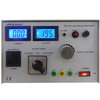I have never considered the "cradle to grave" cost of lamps whether LED, curly-bulb, incandescent, halogen incandescent, neon, or whatever. Years ago
electroluminescent strips were popular "night lights" that apparently lasted forever and consumed very little energy. You can still buy them, but the reason they never took over the lighting market was simple: they were just not bright enough and seemed to come in only one color, a sort of green or turquoise. These handy night lights didn't require any electronics and were inexpensive to manufacture. Electrically they behaved like capacitors and ran fine from household line voltage. Later versions provided a range of colors, but brightness was still lacking.
Electrically powered lighting has never been energy efficient, whether it be arc lamps or LEDs, because the total cost to manufacture and distribute lamps, as well as the infrastructure required to power them and eventually dispose of them, is never considered as a contributing factor to the cost of ownership. How much would it really cost to recover the minute quantity of mercury present in every discarded curly-bulb? What if, instead of mercury, the curly-bulb contained a highly radioactive or extremely toxic substance that absolutely HAD to be removed from the environment? And what about the true cost of all those "green" solar-powered garden-path lamps? Lessee... whup up a mess of silicon, dope it properly, and make some photovoltaic cells and light-emitting diodes. Then figure out the chemistry to make a rechargeable battery to store the electrical energy absorbed during the day and release that energy to a white-light LED during the evening. If you can do all that without cost, congratulate yourself on being "green" and go hug a tree in celebration.
So, unless I learn the fine art of blowing glass bulbs, winding very small diameter tungsten wire into coils and winding those coils into slightly larger coils, then attaching the tungsten ends to wires passing through a glass stem... yada, yada, yada. Even "simple" incandescent light bulbs require more technology to manufacture than is available in my back yard. Goodbye yellow brick road and tungsten filament incandescent lamps. We loved your warm yellow color for awhile and the soft heat you provided. I guess I will now go looking at Wally World for an LED covered heating pad. I wonder if those will be available in a soft yellow or violet color?

